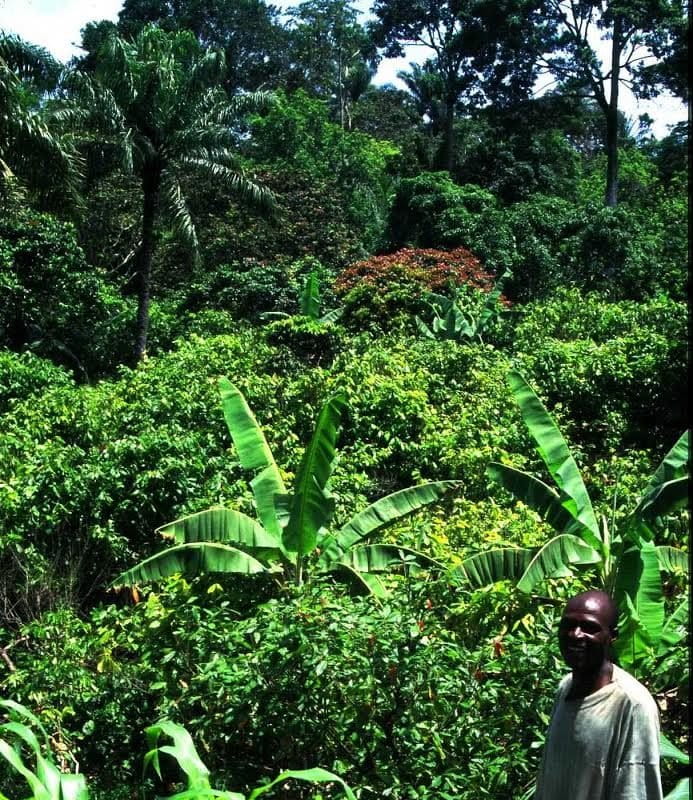
2 January 2018. Trees are much more than the lungs of the world. Beside carbon sequestration, increased food security, biodiversity, topsoil depths, medicine and fiber production, plus other benefits accrue to agroforestry.
 This article is part of a new Mongabay series about the global scope of agroforestry. This post is a commentary by Roger Leakey. Roger Leakey has studied, taught, and written about agroforestry techniques for decades and makes the point that trees are much more than ‘the lungs of the planet,’ but rather they also function like the skin, heart, kidneys, and intestines of the Earth, while acting as pharmacies, factories, and food pantries for humans.
This article is part of a new Mongabay series about the global scope of agroforestry. This post is a commentary by Roger Leakey. Roger Leakey has studied, taught, and written about agroforestry techniques for decades and makes the point that trees are much more than ‘the lungs of the planet,’ but rather they also function like the skin, heart, kidneys, and intestines of the Earth, while acting as pharmacies, factories, and food pantries for humans.At the local level, in addition to these ‘bodily functions,’ trees produce a wide range of products useful to us, and are often traded in local markets. There are literally tens of thousands of trees that produce edible and/or useful products – sources of items of day-to-day importance for us. So, we can also think of trees as shops, civic services, and industries.
Thinking in this way, a treed landscape becomes similar to a town made up of supermarkets full of everyday needs; a bank providing annual interest on investment; a drug store or health clinic for medicines; a water tower; an art gallery; a zoo full of wildlife; a guardian of culture like a museum; a hotel providing rest for migrants; a tourist center for over-wintering or summer breeding habitat; a nightclub for nocturnal creatures; factories for fertilizers, pesticides and drugs; an energy provider, and even a skyscraper affecting the flow of wind around the other buildings.
(...)
This mixed cropping is known as ‘agroforestry’, a farming system which thrives off diversity and maximizes the availability of all the different benefits of trees and their services. In this way, agroforestry is highly beneficial to us – Homo sapiens – a dominant species in this agroecosystem. Agroforestry harnesses numerous environmental, social and economic benefits for our complex lifestyles.
This is especially important in the tropics and sub-tropics where poverty-stricken subsistence farmers struggle to feed their families and scratch a living off highly degraded land. In this situation, it can be described as hunger busting since it can improve food crop yields on exhausted soils; farmer-friendly as it has numerous social benefits including enhanced livelihoods; wildlife-friendly as it provides habitat; climate friendly as it mitigates climate change and controls water flows; wealth-promoting by producing marketable products for businesses and industries, and health-giving by producing nutritious and medicinal products. So, we could create a new, green, and much more sustainable economy.
Looking to the future, there are easily enough useful tree species for agroforestry to play all of the above roles in any corner of the inhabited world, very few of which have been cultivated to date. Interestingly, each of these species contains inherent 3- to 10-fold genetic variability at any one site, so it is easy to find and propagate individual trees that display an infinite number of useful and marketable traits suitable for a new array of businesses and industries.Related:
How does forest-based bioeconomy affect climate, jobs and growth?
3 January 2018. Natural Resources Institute Finland (Luke) and University of Eastern Finland (UEF) have published their view on the role of forest-based bioeconomy in the EU. Furthermore, the position paper proposes what kind of forest research should be prioritized in the EU in the coming years.
The paper stresses that forest-related policies and decision making need to be based on solid scientific evidence to address climate change and to create sustainable growth.
The key policy and, thus, research areas include:
sustainable, resilient and climate-smart forestry
multiple use of forests
transformation from non-renewables towards sustainable bio-based materials
responsive multi-actor forest governance
The position paper is available online here.



No comments:
Post a Comment